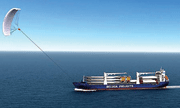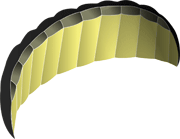E-Archive
Off the Beaten Track
in Vol. 11 - September Issue - Year 2010
Go Fly A Kite!

Ship with kite traction system

Foil kite
Kite flying is a simple and inexpensive form of entertainment which has been around for many centuries and which can be found the world over. There’s something about a brightly colored piece of cloth or plastic fluttering high above one’s head that appeals to young and old alike. An almost mystical bond is formed between the person holding one end of a string on the ground and the flying object at the other end. It is almost as if, in one’s imagination, the kite were the projection of the person’s body flying high in the sky, free of all earthly restraints.
However, in recent years, kites have become the object of serious research as a form of traction and power generation. One field of study which has shown promising results is kite traction applied as an auxiliary form of propulsion on merchant ships.
Rising fuels costs, the knowledge that oil supplies will not last forever and environmental concerns have led to experiments to reduce consumption of fuel by merchant ships, which transport more than ninety percent of world trade. Although shipping is the most energy-efficient mode of transport for goods, it accounts for about five percent of global CO2 emissions, a percentage which some may consider negligible, but which translates into a huge amount of CO2 released into the atmosphere. Theoretically, the use of this technology worldwide could reduce carbon dioxide emissions by over 146 million tons. Compared to the traditional system of masts and sails, kite traction on a ship offers several advantages which helped to overcome initial skepticism when the idea was first presented. A kite can be actively controlled in order to create its own flying speed and increase the traction force, which means more traction power can be created with less sail area. It can be flown at higher altitudes, where winds are stronger and the yield of the kite increases considerably. In fact, kites can achieve a lift-to-drag ratio of at least six to one, giving a ship more power than is possible with masts and sails. The low attachment point of the tow line reduces the roll heeling moment of the ship and there are no masts and riggings occupying valuable deck space.
But the idea has earned more and more serious attention from ship owners because of one overriding advantage: a considerable reduction in fuel consumption. Mathematical studies elaborated at the Delft University of Technology in Holland have postulated that a ship equipped with a properly designed and constructed kite traction system could consume from ten to fifty percent less fuel. Of course actual fuel saving is heavily influenced by several operating conditions, such as wind speed and direction, sea currents, length of the tow cable and the design and yield of the traditional propulsion system installed on the ship.
The most efficient power kites are the foil type, consisting of a number of cells running fore and aft and open at the front to allow air to inflate the kite, making it assume an aerofoil section. This is the same type of kite used for sport-related activities such as kitesurfing and kiteboarding on land.
All this is well and good, but what happens if the wind is blowing in the opposite direction? Studies have shown that it’s possible to save fuel with winds up to fifty degrees off the true stern position of the ship.
The system was tested extensively on the Baltic Sea before commercial implementation and construction of the world’s first hybrid propulsion merchant ship, the MS Beluga Skysails, was completed in December 2007. The ship is equipped with a 160 m² kite attached to a computer-controlled pod, which constantly regulates the kite’s configuration and altitude from 100 to 500 meters. The ship left its home port of Bremerhaven, Germany in late January 2008 for its maiden voyage to Venezuela, where it arrived in early March. While the kite was in use, the ship saved from ten to fifteen percent fuel, equivalent to about $ 1,000 to $ 1,500 per day. There are plans to upgrade the kite to about 320 m², which should boost fuel savings to about thirty percent.
Another 160 m² kite is being installed on Germany’s largest fishing vessel, the Maartje Theadora, where it is expected that the system will lead to considerable fuel savings when the vessel makes its runs to fishing grounds along the coasts of Africa or to the South Pacific.
By Giovanni Gregorat, Contributing Editor MFN & Sales Manager, Pometon Abrasives
Author: Giovanni Gregorat



























